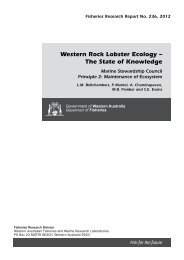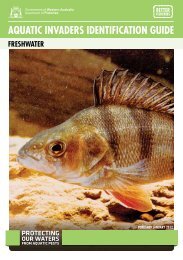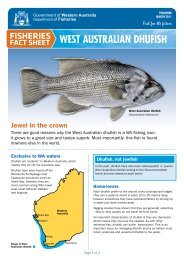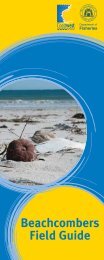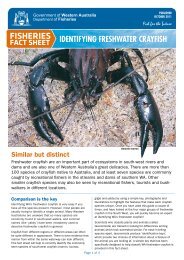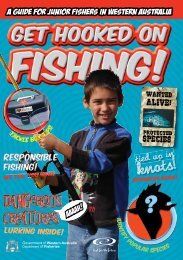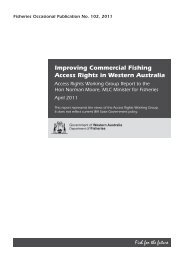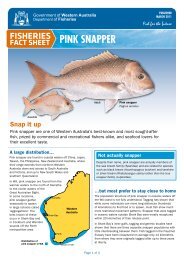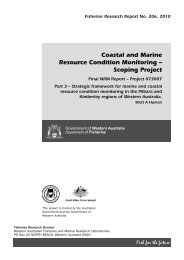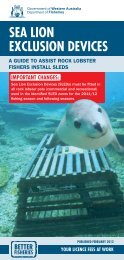Assessment of gonad staging systems and other ... - CiteSeerX
Assessment of gonad staging systems and other ... - CiteSeerX
Assessment of gonad staging systems and other ... - CiteSeerX
Create successful ePaper yourself
Turn your PDF publications into a flip-book with our unique Google optimized e-Paper software.
1.0 IntroductionThe narrow-barred Spanish mackerel (Scomberomorus commerson) is a pelagic, top levelpredator found throughout tropical marine waters <strong>of</strong> the Indo-West Pacific. Juveniles inhabitshallow inshore areas whereas adults are found in coastal waters out to the continental shelf,<strong>and</strong> may reach 240 cm fork length, 70 kg <strong>and</strong> over 15 years <strong>of</strong> age. Adults are usually foundin small schools but <strong>of</strong>ten aggregate at particular locations on reefs <strong>and</strong> shoals to feed <strong>and</strong>spawn. Whilst some individuals may reside in the same area throughout the year, mostmackerel appear to undertake lengthy migrations (Luna 2000, Collette <strong>and</strong> Nauen 1983).S. commerson is <strong>of</strong> major fisheries importance <strong>and</strong> targeted throughout its range bycommercial, artisanal <strong>and</strong> recreational fishers. The main methods <strong>of</strong> capture are drift nets<strong>and</strong> trolling lines. Estimated global catches <strong>of</strong> this species between 1993 <strong>and</strong> 1998 rangedfrom 124 570 to 158 735 t, with most catches obtained from the central western Pacific <strong>and</strong>western Indian Ocean regions (FAO 2000).Commercial catches <strong>of</strong> S. commerson in Australian waters are minor compared to <strong>other</strong>regions, varying from 1 191 to 1 635 t between 1993 <strong>and</strong> 1998 (FAO 2000). Approximatelyone third <strong>of</strong> this catch was taken along the Western Australian (WA) coast betweenGeraldton <strong>and</strong> the Northern Territory border, making S. commerson one <strong>of</strong> the most valuablefinfish species in Western Australia. Although 75 commercial fishing vessels reportedcatches <strong>of</strong> Spanish mackerel in 1999, only about ten <strong>of</strong> these specifically targeted mackerel.A significant number <strong>of</strong> S. commerson are also caught by recreational anglers as far south asGeographe Bay (Crowe et al. 1999, Sumner et al. in press).The main method used to capture S. commerson in WA is trolling, using either lures orbaited hooks. In the commercial fishery up to seven lines are trolled at a time, with braidednylon or rope ‘sash’ cord attached to heavy wire trace traditionally used as the main line.Sash cord is still used in the north <strong>of</strong> WA but has been replaced by lighter mon<strong>of</strong>ilament lineelsewhere in the state. Due to concerns over increased catches <strong>and</strong> anecdotal evidence tosuggest that the species is under the threat <strong>of</strong> overfishing, an Interim Management Plan(IMP) is currently under review. The capture <strong>of</strong> S. commerson by commercial <strong>and</strong>recreational fishers is also subject to a minimum legal size <strong>of</strong> 90 cm total length <strong>and</strong> arecreational bag limit <strong>of</strong> four fish per day per angler.1.1 Research on S. commerson in Western AustraliaA joint Commonwealth Department <strong>of</strong> Primary Industry <strong>and</strong> WA Department <strong>of</strong> Fisheries<strong>and</strong> Wildlife research program was undertaken between July <strong>and</strong> October 1981 to gatherdata on the distribution <strong>and</strong> abundance <strong>of</strong> S. commerson along the north west coast <strong>of</strong> WA(Donohue et al. 1982). Preliminary biological, catch per unit effort <strong>and</strong> economic data werealso gathered to assess the viability <strong>of</strong> commercially fishing for mackerel in the north. Morerecent concern over the continued exploitation <strong>of</strong> S. commerson has led to the initiation <strong>of</strong>two new research projects. The first <strong>of</strong> these, a joint WA-NT-QLD project funded by theFisheries Research <strong>and</strong> Development Corporation (FRDC; Project # 98/159), wascommenced in 1998 to determine the stock structure <strong>of</strong> S. commerson in Australian watersusing genetic markers, otolith stable isotope ratios, <strong>and</strong> parasitic fauna. The second project,also funded by the FRDC (Project # 99/151), began in 1999 <strong>and</strong> will assess the status <strong>of</strong> S.2 Fish. Res. Rep. West. Aust.2001, 136, 1-32



